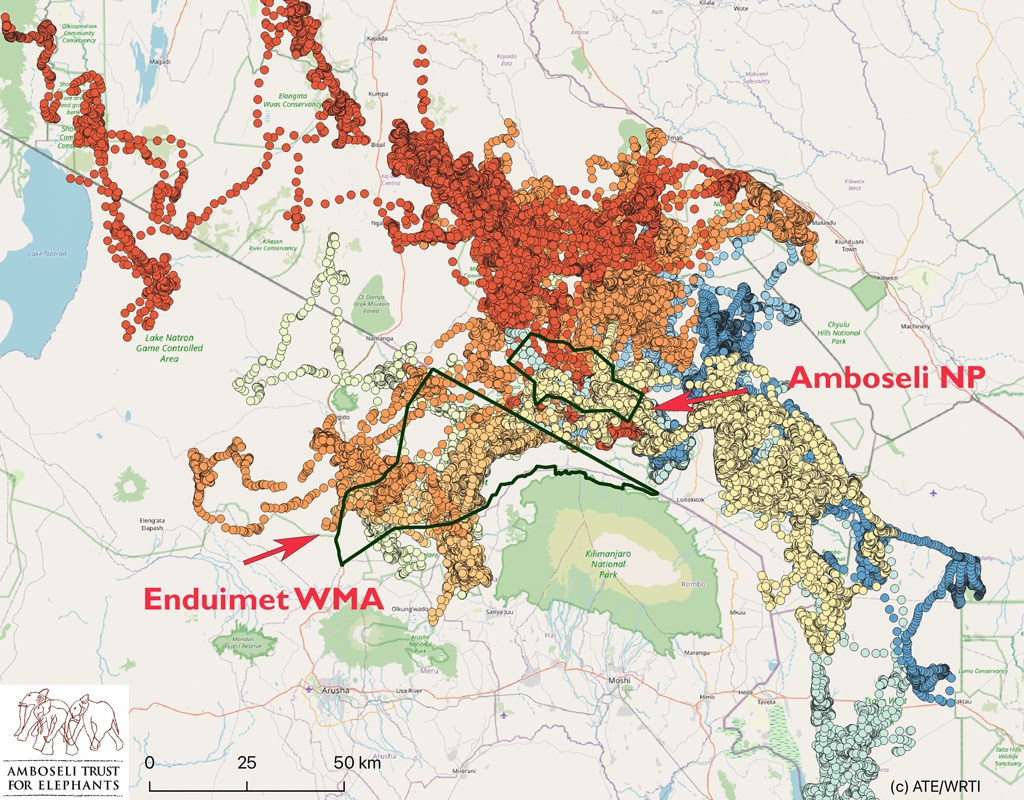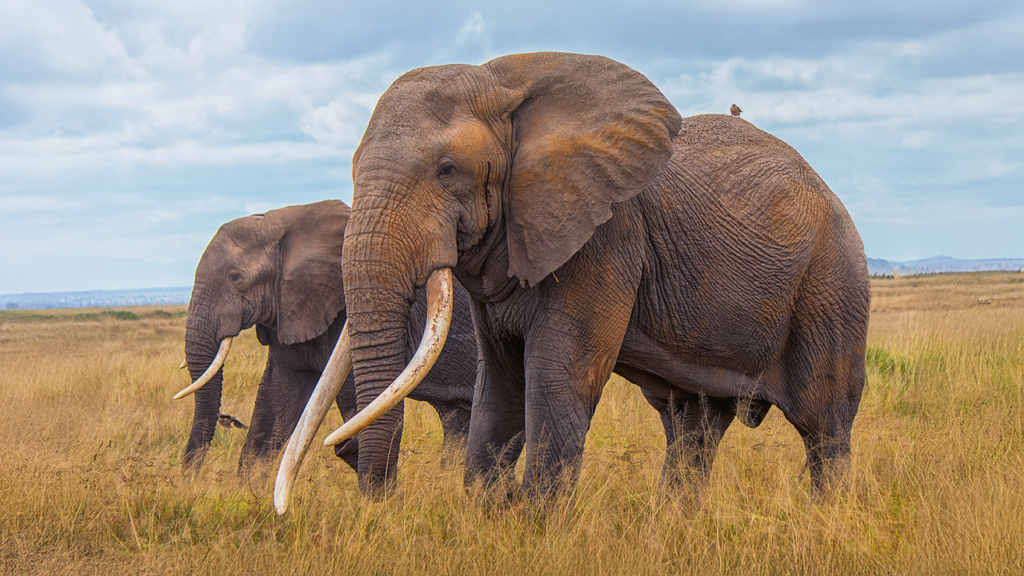Trophy hunting is decimating super tuskers on the Kenya-Tanzania border
Despite an agreement between Kenya and Tanzania prohibiting borderland hunting, Tanzania has allowed the hunting of bull elephants to expand.
Published on 04 October 2024 in
ISS Today
By
Valtino Omolo
Intern, East Africa Peace, Security and Governance, ISS Nairobi
Despite their declining numbers, super tuskers – bull elephants with tusks weighing over 45 kg each – are being slaughtered by international sport hunters in the Amboseli ecosystem, which stretches along the Kenya-Tanzania border.
This hunting is licensed by Tanzania, despite a 1995 agreement between the two countries prohibiting borderland hunting after four Amboseli elephants were killed in 1994.
Fewer than 30 super tuskers remain worldwide, with only 10 left in the Amboseli ecosystem. This means super tuskers are on the brink of extinction both regionally and globally. Their vulnerability to extinction is exacerbated by the fact that they are often killed in their prime reproductive years. Males aged 40-54, known to have the largest tusks, have the highest reproductive success.
In March this year, Joseph Ole Lenku, Governor of Kenya’s Kajiado County, raised concerns over three super tuskers killed within the Amboseli ecosystem. Five have also reportedly been killed so far this year in Tanzania’s Enduimet area, around 40 km from the Kenya-Tanzania border. The elephants were part of a 2 000-strong herd that traverse Kenya’s Amboseli National Park and Tanzania’s Enduimet Conservation Area.
Elephant movements from the Amboseli Conservancy into the Enduimet area, Kenya-Tanzania border

Source: Africa Geographic, 2024
According to Big Life Foundation Executive Chair Richard Bonham and Dr Paula Kahumbu, Chief Executive of WildlifeDirect, these borderland jumbos frequently cross the Kenya-Tanzania border to forage for food, exposing them to conflicting conservation jurisdictions.
Trophy hunting in Tanzania is governed by clearly outlined regulations. The Tanzania Wildlife Management Authority specifies that hunting is permitted only between 1 July and 31 December. The regulations also highlight that hunters need to present proof of their kill afterwards, in the form of skin, hooves and other non-edible animal parts.
Trophy hunters in Tanzania reportedly pay between US$10 000 and $20 000 to hunt super tuskers. Although the government issues these permits, many licensed hunters do not adhere to the regulations that control the permits, leading to their misuse.
The most recent super tusker killings show a clear violation of Tanzania’s hunting regulations. Not only were the elephants hunted outside the permitted hunting period, but their carcasses were intentionally burnt beyond identification. These breaches point to non-compliance and inadequate regulation oversight, casting doubt on trophy hunting transparency.
Fewer than 30 super tuskers remain worldwide – with only 10 left in the Amboseli ecosystem
Regulations have been flouted since the lifting of a ban on hunting for trophies and bush meat in 2018. The ban was initially imposed in 2015 to halt the abuse of hunting permits. In 2022, Tanzania’s Tourism Minister Damas Ndumbaro travelled to Las Vegas to market the country’s hunting safaris to wealthy American tourists and other trophy-hunting investors. Both actions have allowed for the expansion of trophy hunting in Tanzania, notwithstanding concerns over non-compliance with the regulations.
The recent incidents have also raised concerns about a resurgence of criminal activity in the trophy-hunting industry. Of particular concern is the potential role of criminal syndicates in the wildlife sector, as was the case in 2018 when Tanzania’s trophy hunting industry was implicated in wildlife trafficking. This mainly involved ‘pseudo-hunting’ – using trophy hunting to cover up illegal activities such as wildlife trafficking or poaching.
At the time, trophy hunts served as a ruse for acquiring and exporting valuable parts of protected animals for illegal trade. Former tourism minister Hamisi Kigwangalla accused hunting operators of being involved in poaching, illegally exporting ivory and having ties to the now-arrested ‘Ivory Queen’, Yang Fenglan. But the involvement of government officials in this illegal trade also highlighted the role of corruption in the wildlife sector.
While trophy hunting has economic benefits for Tanzania, pseudo-hunting has many negative consequences
While trophy hunting has economic benefits for Tanzania, pseudo-hunting has many negative consequences. The Tanzanian government and relevant stakeholders must take decisive action to protect the region’s rich biodiversity. This is especially critical given that Tanzania lost 60% of its elephants in just five years leading up to 2014, though their numbers have since partially recovered.
Comprehensive reforms are urgently needed to enhance transparency and accountability in wildlife and conservation efforts. Tanzania could draw from the good practices implemented by regional neighbours, South Africa, Kenya and Zimbabwe.
Kenya’s stringent wildlife protection laws and its use of monitoring technology demonstrate the importance of a strong legal framework and real-time data access. Zimbabwe’s quota system emphasises the value of scientifically determined quotas and species-specific protections. And South Africa advocates for ‘sustainable hunting practices’ that seek to protect elephants within reproductive ages. Together, these approaches ensure sustainable hunting practices and protect endangered species.
Cross-border elephants provide immense socio-ecological value to the Amboseli and Enduimet ecosystems
The implementation of independent oversight mechanisms is also crucial. Zimbabwe’s Parks and Wildlife Management Authority and the Kenya Wildlife Service provide effective models for monitoring and enforcing regulations. By adopting such approaches, countries can ensure that conservation efforts are transparent and effective, leading to better wildlife protection and more sustainable management of hunting activities.
Curbing wildlife trafficking disguised as trophy hunting also requires cooperation between the countries, including intelligence and resource sharing, to jointly tackle wildlife crime syndicates. The likely involvement of corrupt government officials makes increased vigilance even more important.
Conservation scientists have appealed to Tanzanian authorities to recognise the immense socio-ecological value that cross-border elephants provide to the Amboseli and Enduimet ecosystems and cooperate with counterparts in Kenya to protect this giant of Africa.
This article was first published by the ENACT project.
Exclusive rights to re-publish ISS Today articles have been given to Daily Maverick in South Africa and Premium Times in Nigeria. For media based outside South Africa and Nigeria that want to re-publish articles, or for queries about our re-publishing policy, email us.
Source link : https://issafrica.org/iss-today/trophy-hunting-is-decimating-super-tuskers-on-the-kenya-tanzania-border
Author :
Publish date : 2024-10-04 09:13:14
Copyright for syndicated content belongs to the linked Source.
